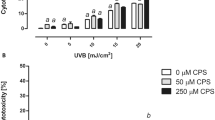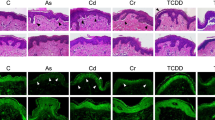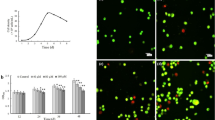Abstract
Recent epidemiological studies have brought to light a possible link between premalignant or neoplastic skin lesions (Bowen disease, squamous carcinoma) and occupational exposure to 4,4′-bipyridyl (4,4′B), a precursor in the synthesis of paraquat herbicide. The present study used a serum-free cell culture of normal human keratinocytes (NHK) and two skin-equivalent models to test the effects of exposure to different concentrations of 4,4′B.
Cytotoxicity of 4,4′B on NHK was measured by neutral red release assay. Superoxide dismutase (SOD) activity and cell cycle were analyzed in exposed and nonexposed NHK cultures. Histological and immunohistological tests enabled evaluation of differentiation and proliferation effects in reconstructed-skin models.
Results showed that significant cytotoxicity occurred after 5 to 11 days' exposure to 4,4′B concentrations of 10-6-10-3 mol/L (IC50 between 10-3 and 10-4 mol/L 4,4′B after 11 days). Parallel modifications of SOD activity were recorded. Histological and immunohistological analysis revealed dose-related 4,4′B effects in reconstructed skin models. This involved abnormal terminal differentiation, connected with filaggrin expression, observed in skin models exposed to 10-7 and 10-6 mol/L 4,4′B. However, no modification of cell cycle or dysplasia was detected as a result of exposure to 4,4′B.
Thus, 4,4′B appears to be cytotoxic for NHK, but as an isolated contaminant, and is unable to induce keratinocyte dysplasia in vitro. These preliminary results do not exclude a cocarcinogenic action of 4,4′B (with UVB for example).
Similar content being viewed by others
References
Babich H, Borenfreund E. Applications of the neutral red cytotoxicity assay to in vitro toxicology. Alternatives Lab Anim. 1990a;18:129–44.
Babich H, Borenfreund E. Cytotoxic effects of food additives and pharmaceuticals on cells in culture as determined with the neutral red assay. J Pharmacol Sci. 1990b;79:592–4.
Barlogie B, Raber M, Schumann J et al. Flow cytometry in clinical cancer research. Cancer Res. 1983;43:3982–97.
Basset-Séguin N, Culard JF, Kerai C et al. Reconstituted skin culture: a simple method with optimal differentiation. Differentiation. 1990;44:232–8.
Blair A, Zham S. Cancer among farmers. Occup Med. 1991; 6:335–54.
Bowera G, Duffield D. Premalignant and neoplastic skin lesions associated with occupational exposure to "tarry" byproducts during manufacture of 4,4'bipyridine. Br J Ind Med. 1982;39:76–81.
Cappelletti G, Incani C, Maci R. Paraquat induces irreversible actin cytoskeleton disruption in cultured human lung cells. Cell Biol Toxicol. 1994;10:255–63.
Dang PM, Chable H, Bernard P. Decreased superoxide dis-mutase activity in keratinocytes from patients with xeroder-ma pigmentosum. Eur J Dermatol. 1996;6:247–8.
Elliot WM, Auersperg N. Comparison of the neutral red and methylene blue assays to study cell growth in culture. Biotech Histochem. 1993;68:29–35.
Franklin MR. Drug metabolizing enzyme induction by simple diaryl pyridines: 2-substituted isomers selectively increase only conjugation enzyme activities, 4-substituted isomers also induce cytochrome P450. Toxicol Appl Pharmacol. 1991;111:24–32.
Gunnarsdottir H, Rafnsson V. Cancer incidence among Icelan-dic farmers, 1977-1987. Scand J Soc Med. 1991;19:170–3.
Haguenoer J, Cordier S. Occupational risk factors for upper respiratory tract and upper digestive tract cancer. Br J Ind Med. 1990;47:380–3.
Knaggs HE, Holland DB, Morris C, Wood EJ, Cunliffe WJ. Quantification of cellular proliferation in acne using the monoclonal antibody Ki-67. J Invest Dermatol. 1994;102: 89–92.
Kuo M-L, Lin J-K. The genotoxicity of the waste water discharged from paraquat manufacturing and its pyridyl components. Mutat Res. 1993;300:223–9.
Lehman A, Bridges RB. Sunlight-induced skin cancer: some new aspects and implications of the xeroderma pigmento-sum model. Br J Dermatol. 1990;122:115–9.
Li W. Premalignant skin lesion associated with occupational exposure during the manufacture of herbicide paraquat. Dermatol Clin. 1984;2:1–8.
Mils V, Simon M, Vincent C, Michel S, Serre G. A new late differentiation antigen of human cornified epithelia, defined by the monoclonal antibody D40-10, characterizes a sub-population of keratohyalin granules. Eur J Dermatol. 1992; 2:100–8.
Molès JP, Schiller JT, Tesnière A, Leigh IM, Guilhou JJ, Basset-Séguin N. Analysis of HPV16 E6 and mutant p53-trans-fected keratinocytes in reconstituted epidermis suggests that wild-type p53 inhibits cytokeratin 19 expression. J Cell Sci. 1994;107:435–41.
Nebot C, Moutet M, Huet P, Xu J, Yadan J, Chaudiere J. Spectrophotometric assay of superoxide dismutase activity based on the activated autooxidation of a tetracyclic cate-chol. Anal Biochem. 1993;214:442–51.
Nishigori C, Miyashi Y, Inamura I, HT. Reduced superoxide dismutase activity in xeroderma pigmentosum fibroblasts. J Invest Dermatol. 1989;93:506–10.
Pearce N, Sheppard R. Leukemia among New Zealand agricul-tural workers. A cancer registry based study. Am J Epide-miol. 1986;124:402–9.
Pick E, Mizel D. Rapid microassays for the measurement of superoxide and hydrogen peroxide production by macro-phages in culture using an automatic enzyme immunoassay reader. J Immunol Methods. 1981;46:211–26.
Rat P, Korwin-Zmijowska C, Warnet J-M, Adolphe M. New fluorimetric microtitration assays for toxicological screen-ing of drugs. Cell Biol Toxicol. 1994;10:329–37.
Schallreuter KU, Pittelkow MR, Wood JM. Defects in anti-oxidant defense and calcium transport in the epidermis of xeroderma pigmentosum. Arch Derm Res. 1991;283:449–55.
Serre G, Mils V, Haftek M et al. Identification of late differ-entiation antigens of human cornified epithelia, expressed in re-organized desmosomes and bound to cross-linked envel-ope. J Invest Dermatol. 1991;97:1061–72.
Simon M, Sebbag M, Hafteh M et al. Monoclonal antibody to human epidermal filaggrin, some not recognizing profilag-gin. J Invest Dermatol. 1995;105:432–7.
Smith A, Bates M. Epidemiological studies of cancer and pesticide exposure. J Am Chem Soc. 1989;13:208–22.
Stark AD, Chang HG. A retrospective cohort study of cancer incidence among New York state farm bureau members. Arch Environ Health. 1990;45:155–62.
Vindelov L, Christensen I, Nissen N. A detergent trypsin method for the preparation of nuclei for flow cytometric DNA analysis. Cytometry. 1983;3:323–7.
Wang J, Li W. Occupational risk and development of premalig-nant skin lesions among paraquat manufacturers. Br J Ind Med. 1987;44:196–200.
Whitaker C, Lee W. Squamous cell skin cancer in the North West of England, 1967-1969, and its relation to occupation. Br J Ind Med. 1979;36:43–51.
Wiklund K, Holm L. Trends in cancer risk among Swedish agricultural workers. J Natl Cancer Inst. 1986;77:657–64.
Author information
Authors and Affiliations
Rights and permissions
About this article
Cite this article
Michel-Buono, M., Buono, JP., Serre, G. et al. In vitro cytotoxic effects of 4,4′-bipyridyl on normal human keratinocytes. Cell Biol Toxicol 13, 193–204 (1997). https://doi.org/10.1023/A:1007314430645
Issue Date:
DOI: https://doi.org/10.1023/A:1007314430645




